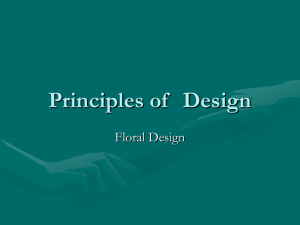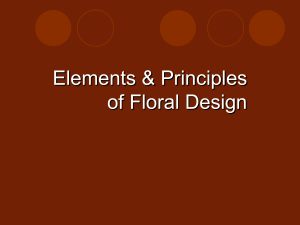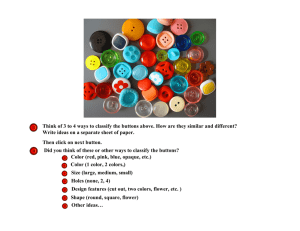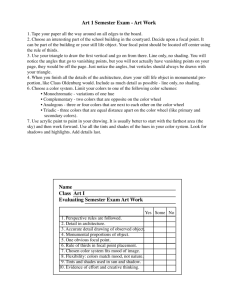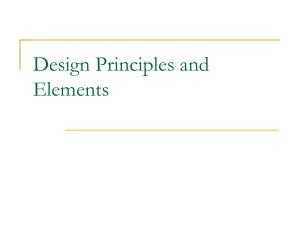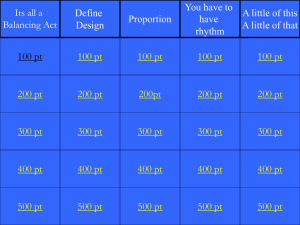Principles of Design Floral Design
advertisement
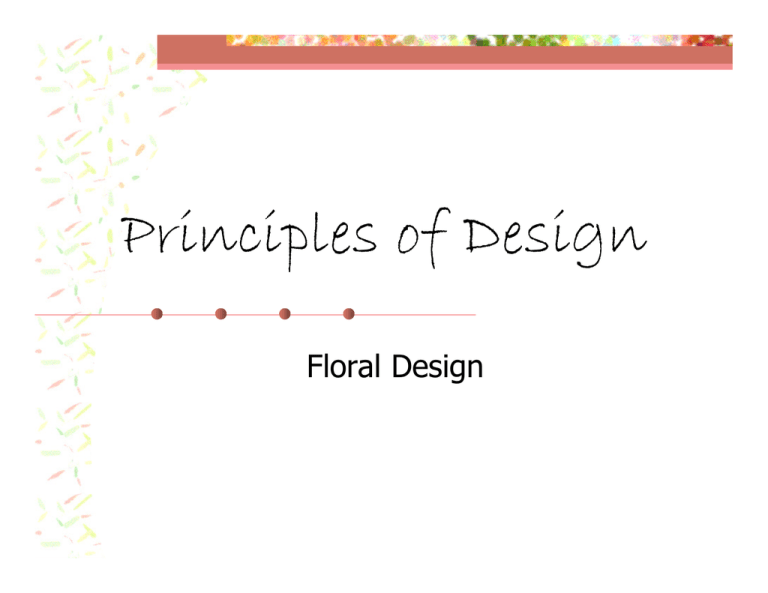
Principles of Design Floral Design Principles The principles of design are the "guidelines" of design. These six qualities either please or displease the eye of the viewer. Harmony Unity Balance Scale & Proportion Focal Area & Accent Rhythm Harmony The effect of matching and blending materials together The combination of materials, colors, and textures that create a composition that is pleasing to the eye. Accomplished by arranging appropriate flowers and colors to fit a container within its setting. Activity Find or draw an example of a harmonious flower arrangement. Be sure to match the colors, textures, and styles within the arrangement. Unity A blending together of all parts when viewed as a whole. Think of a wedding “unity” candle. This represents 2 people becoming one, being united. A “oneness” of purpose, of all parts in the design. This includes: Vase/Container Flowers Foliage Color harmony Accessories Achieved by combining all of the materials for a single purpose. Examples of Unity Elegant rooms with bold colors (drapes, wallpaper, furniture) will need a floral arrangement fitted for that setting. This could be done using flowers with bold colors and elegant accessories. In a formal setting, candlelight would be appropriate. If using one color in the design, be sure to blend (unify) the entire design together by bringing touches of the same colors throughout the whole design. Activity Find (or draw) a picture of an arrangement with candles and ribbon that demonstrates unity. Balance The actual (physical) and visual stability in a design. Actual Balance Physically stable, so the design won’t fall over or tip forward Think of a teeter-totter (balance each side) Visual Balance So the viewer sees the design as being pleasing to the eye Where the plant material is equal on both sides of an imaginary line Imagine a line down the middle of the design (line can be vertical or horizontal), plant material should be the same on either side Can be achieved with symmetrical balance or asymmetrical balance Balance Symmetrical balance Uses equal amounts of color and form on either side of the central axis Asymmetrical balance Uses dissimilar (not the same) amounts and placements to achieve visual balance Activity Draw or find an example of a cascading bouquet that is balanced. Remember physical and visual balance. Proportion The relation of one portion to another or one area to the whole, and the quantity of plant material in relation to container and accessories. How much you use of anything in comparison to the other parts of the design In floral design, the appropriate proportion is: 1/3 container 2/3 floral design The Golden Mean The Golden Mean = .618 In art there is a proportion called the Golden Section or Mean Considered the perfect proportion, it is also called the Divine Proportion It is used in the great paintings of the Renaissance, and in Greek art and architecture Often found in nature, such as the spiral of a shell Adds harmonious composition to buildings and structures It is proven that the human eye has a preference for proportions using the Golden Mean Activity Draw an example of a flower arrangement with the appropriate relation of size of container to design. Scale The comparative size of the individual parts to each other, to the whole, and the space. Includes all the parts of the arrangement: Container Flowers Foliage Accessories Table/Setting Activity Describe an example of a small floral design piece that is appropriate in size. head wreath for flower girl, corsage, boutonnière Describe an example of a large floral design piece that is appropriate in size. altar piece for church, Christmas tree or wreath Now, find or draw a centerpiece that is appropriate for a wedding table. Consider the guests: do they want to see across the table? through the arrangement? over the arrangement? under the arrangement? does everyone have a nice view of the arrangement? Focal Area & Accent The center of attention Focal point of the design Area of most importance or greatest impact Area of dominance to which the eye is drawn Usually the point from which the design originates – lower center of the design Focal Area & Accent Creating a Focal Point: Bright Bold Color Size of Flower Grouping of Flowers Adds emphasis or visual weight to the design Creating an Accent: Used to emphasize something in one area Rather than the dominate feature, it is an enhancement to the focal area A single or recurring detail that adds to the interest of the overall design Examples include a bow, glittery or sparkly item, accessory, etc. Activity! Include an example. You can choose your own colors or flower types, but be sure to emphasize one place in the arrangement with a focal point and accent. Rhythm The visual movement achieved in design by repetition, graduation, variation, or radiation Implies motion and rest in a design Used to move the viewers focus from one point to another Line materials used for rhythm: Ribbon Rope Twigs Grasses Usually achieved by graduation or contrast Graduation Done by grading flowers: Place the smallest flowers at the edges of the arrangement Place the largest flowers at the bottom or in the area of prominence Done by grading colors: Strong colors at the focal area Lighter colors should be placed further out This moves the viewers focus from the stronger colors to the weaker ones Activity Find or draw an example of graduation (using color or size). Contrast Used because the eye needs to rest for a moment on a design, before it travels to another pathway Create calm spots and areas of interest in a design Created by using round forms or flat, smooth leaves To create movement: Repeating several line forms with variation can create a strong visual movement Activity Find or draw a wreath with visual movement and calm spots.
